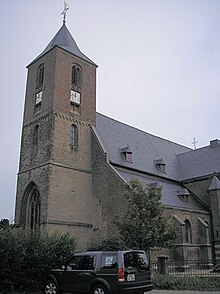Keeken
|
Keeken
City of Kleve
|
|
|---|---|
| Coordinates: 51 ° 50 ′ 44 " N , 6 ° 4 ′ 57" E | |
| Height : | 12 m |
| Area : | 9.86 km² |
| Residents : | 718 (December 31, 2015) |
| Population density : | 73 inhabitants / km² |
| Incorporation : | 1st July 1969 |
| Postal code : | 47533 |
| Area code : | 02821 |
Keeken is a scattered village on the Lower Rhine , right on the German-Dutch border, and part of the city of Kleve . At the end of 2015, Keeken had 718 inhabitants (as of December 31, 2015) (2009: 788; 2005: 768; 2004: 716). The agricultural village covers an area of 9.86 km² (10% of the Klever city area) and is located at an average height of 12 meters above sea level . It has five country roads and around 21 kilometers of city roads.
The village of Keeken is located in the middle of the Düffel nature reserve . Large surrounding areas are protected according to the Fauna-Flora-Habitat Directive (FFH) and the European Directive for the Conservation of Wild Birds ( Bird Protection Directive ).
With only 78 inhabitants per square kilometer (2005), Keeken is the fourth least populated district of the city of Kleve (after Salmorth , Warbeyen and Wardhausen ).
75% of the Keekener are of a Catholic denomination, around 9% are of a Protestant denomination and a further 16% belong to another denomination or no denomination.
In addition to the Catholic and Protestant churches, the Keekener Windmill is the town's third landmark. It was commissioned by the Count of Bylandt in January 1811 and was in operation as a grain mill until 1956. Today it houses a retirement home.
history
The village of Keeken (Keckincghem = Kekene) is of Franconian origin. From around 990 it was the widow's residence of the less virtuous Countess Adela , wife of Immedinger Immed IV. And daughter of Wichmann von Hamaland , who married Count Balderich for the second time . House Keeken (later Wasserburg Haus Halt ) is mentioned in documents from the 8th and 9th centuries . The year the first church was founded is unfortunately unknown. Like Düffelward, Keeken is first recorded in the Xanten collegiate church's death calendar , for example in a document drawn up around 1170 next to Rütger van der Horst and the burgrave Suether von Cleve, a Primanus von Keeken. The right to appoint the church in Keeken was held by the monastery of Xanten. In the Middle Ages, Keeken belonged to the Archdiocese of Cologne , today it belongs to the Diocese of Münster .
The sovereign, the Duke of Kleve , who had been in charge since the 14th century , claimed the right of presentation and in 1553 appointed Johann van Arntzen as pastor in Keeken. Despite the objection of the Xanten cathedral chapter, the dukes of Kleve upheld this right. Since then, the pastoral position has been filled alternately by the Xanten cathedral chapter and the sovereign. In 1646, Count Adrian von Bylandt received jurisdiction over Keeken, Bimmen and Düffelward from the Great Elector for 5000 Reichstaler . There has also been a Protestant church in Keeken since 1728.
The moated castle Haus Halt went under in the 18th century.
In the French period from 1794/98 (mairie in the Napoleonic department de la Roer ) and from 1816 after the return to the Kingdom of Prussia , there was an office of Keeken until 1945 , from which the office of cattle became.
On July 1, 1969, Keeken was incorporated into Kleve. The four-class elementary school Keeken was closed in 2010 due to insufficient new registrations.
Tourism
Especially in the winter months, Keeken is a popular attraction for tourists from home and abroad, as thousands of wild geese from Siberia and Scandinavia keep their winter quarters here and populate the fields and pastures in large flocks. In the summer months, the area offers ideal opportunities for recreation, especially for cyclists, with a well-developed network of cycle paths and agricultural paths with little car traffic. In addition to a catering business with guest rooms, private individuals also offer holiday apartments directly in the village.
Information center "De Gelderse Poort"
Keeken is home to one of the four information centers of the nature reserve " De Gelderse Poort " ("The Gateway to Gelderland "). In the rooms of an old farm it shows a lot about life on and in the Rhine. Interactive models of the landscape enable the visitor to understand the topographical development of the region from the Ice Age to the present day at the push of a button. A model of the surrounding landscape about six meters in size explains, with the support of audio texts, the effects a Rhine flood has on the region and the nature reserve (a flood is simulated by pumping water into the model). An adjoining reading room, specimens from native birds and an aquarium with fish living in the Rhine complete the offer.
Personalities
- Joseph Bautz (1843–1917), German Roman Catholic priest and theologian
- Jürgen von Dückerhoff (* 1973), German artist and graphic designer
Individual evidence
- ↑ a b Kleve in brief. In: kleve.de. Retrieved April 23, 2019 .
- ↑ Kleve in brief. Retrieved April 5, 2013 .
- ^ City of Kleve, district of Keeken. Retrieved April 5, 2013 .
- ↑ Heinrich Scharpegge: Assumption Church. Retrieved December 17, 2019 .
- ^ Office of Keeken. genWiki, accessed December 17, 2019 .
- ↑ Martin Bünermann: The communities of the first reorganization program in North Rhine-Westphalia . Deutscher Gemeindeverlag, Cologne 1970, p. 80 .
- ↑ Vacancy in the staff room | April 17, 2012
- ↑ online





